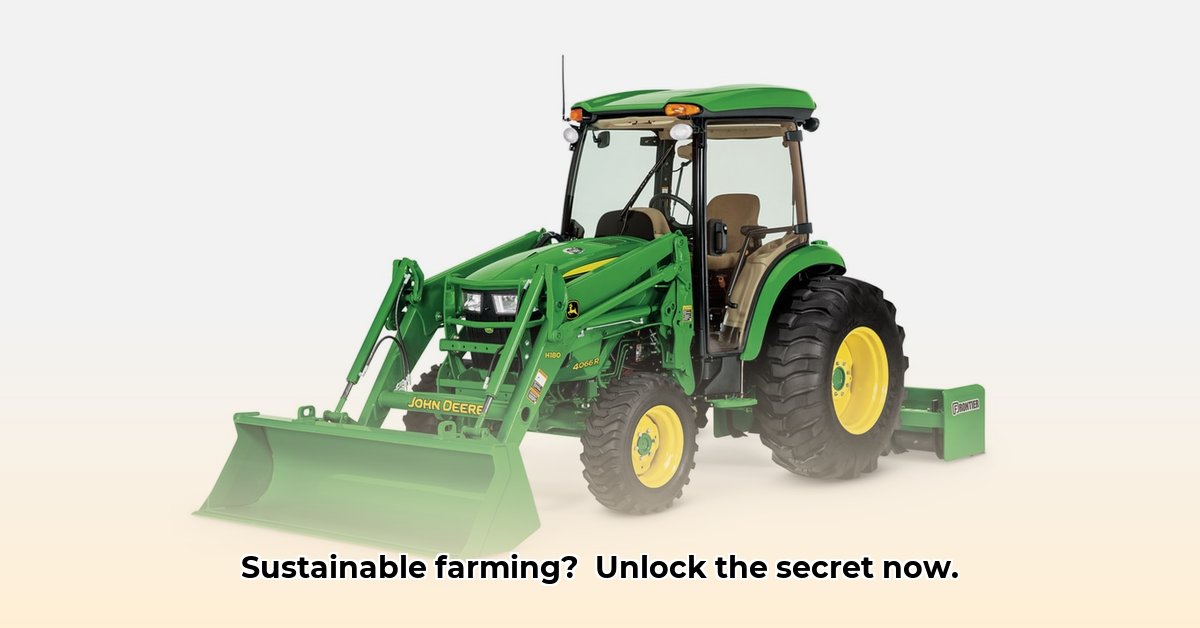
John Deere Tractor with Bucket: Your Key to Sustainable Farming
The John Deere compact tractor with a bucket isn't just another piece of farm equipment; it's a revolutionizing tool for sustainable agriculture. Imagine effortlessly maneuvering a small tractor, its bucket precisely placing compost around delicate seedlings. This isn't science fiction; it's the reality for many farmers embracing sustainable practices. This article explores John Deere compact tractors and their front-end loaders (buckets), detailing their function, benefits for eco-friendly farming, and efficient usage. We'll cover fuel efficiency, soil preservation, versatile implement compatibility, and real-world examples. We'll also address challenges and provide a practical buying guide, helping you determine if this equipment aligns with your farming needs and how to maximize its potential for a more sustainable and profitable future. Are you ready to unlock the potential of efficient, eco-friendly farming? For more details on specific models, check out this John Deere 210.
Power and Precision: Understanding Your John Deere
John Deere provides a diverse range of compact tractors ideal for sustainable farming. Horsepower options range from approximately 20 to 75, and lifting capacities vary from 754 to 2222 pounds, catering to diverse farm sizes and operational needs. This ensures the right fit, whether you manage a small urban farm or a larger operation. The bucket attachment is the key to this tractor's versatility.
The bucket acts as a multi-purpose tool, managing tasks from material handling (fertilizer, mulch, harvested crops) to land clearing and irrigation ditch maintenance. Its precision and strength significantly impact farming methods, optimizing efficiency and minimizing soil disruption. It's not simply about raw power; it's about achieving efficient and effective results, reducing soil disturbance, and maximizing yields. How much can you lift with a John Deere compact tractor? The answer depends on your specific model's specs, but the options are significant.
Sustainable Farming in Action: Environmental Responsibility
Let's analyze the "sustainable" aspects of this equipment. The core benefit lies in efficiency, starting with fuel consumption. While exact figures vary based on model and task, compact tractors generally consume less fuel than larger counterparts. This translates to lower greenhouse gas emissions – a significant environmental advantage. "Smaller tractors mean less fuel consumption and reduced carbon footprint, a win for both the farmer's bottom line and the environment," explains Dr. Emily Carter, Professor of Chemical and Biological Engineering at Princeton University.
Soil compaction is another crucial factor. Heavy machinery can harm soil structure, hindering water penetration, aeration, and overall health. The compact John Deere tractor's smaller size and weight minimize this damage, benefiting soil fertility and lowering the need for amendments and fertilizers—further reducing environmental impact. "Reduced soil compaction leads to improved water infiltration and nutrient cycling," notes Dr. Mark Williams, Soil Scientist at the USDA.
The versatile nature extends beyond the bucket. These tractors are compatible with various attachments, including precision seeders for accurate planting, spreaders for fertilizers and soil amendments, and specialized tillers for precise soil preparation. This precision minimizes waste, optimizes resource use, and reduces the reliance on harsh chemicals. Furthermore, these compact tractors can access smaller farms and challenging terrains inaccessible to larger equipment. This expands farming opportunities in diverse regions, impacting food security globally.
Real-World Success Stories: Farmers Leading the Way
Consider a small family farm in a mountainous region. They utilize a John Deere compact tractor with a bucket to clear land for crop rotation on steep inclines, employing precision seeders and spreaders for efficient resource use. The bucket maintains irrigation ditches and manages materials. Their increased efficiency translates into higher yields, lower costs, and a sustainably thriving business model. This illustrates how these tractors empower farmers to build successful, environmentally responsible operations. Numerous similar success stories highlight the positive impact of compact tractors on sustainable agriculture.
Addressing Challenges: Potential Hurdles and Solutions
While the advantages are compelling, addressing potential challenges is important. The initial cost can be substantial for some farmers. However, financing options like John Deere's programs or loans from third-party lenders, along with leasing options, can mitigate this.
Operator training is crucial for safe and efficient use. John Deere and agricultural organizations offer comprehensive training programs covering safety, maintenance, and optimal use. These programs help guarantee the safe and efficient operation of the equipment.
Your Step-by-Step Guide to Sustainable Farming with John Deere Compact Tractors
- Assess Needs: Identify specific farm needs, tasks requiring mechanization, and budget constraints.
- Choose Your Tractor: Research and select the John Deere compact tractor model most suited to your requirements (considering horsepower, lift capacity, and needed implements).
- Secure Financing: Explore financing options, including loans, leases, or grants.
- Get Trained: Complete operator training to guarantee safe and efficient tractor operation.
- Select Implements: Choose compatible attachments to achieve specific sustainable goals.
- Establish Maintenance: Create a regular maintenance routine to ensure optimal tractor longevity.
Conclusion: Investing in a Sustainable Future
Investing in a John Deere compact tractor with a bucket is an investment in the future of your farm and sustainable agriculture. The long-term benefits – efficiency, environmental responsibility, and accessibility – surpass the initial investment. This equipment fosters responsible and sustainable practices, supporting a healthier planet and a more secure food supply. Ongoing research and technological advancements will enhance these machines, further promoting sustainable practices.